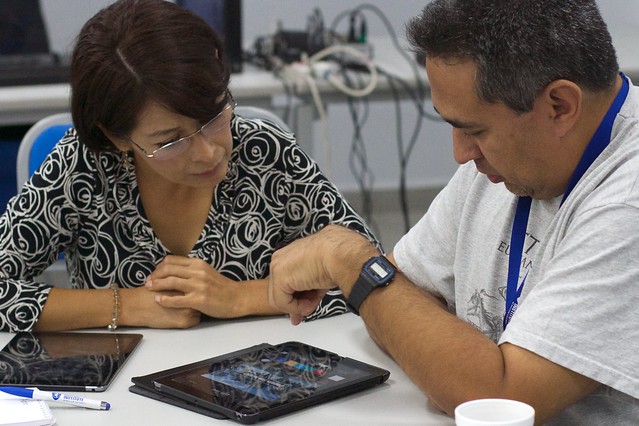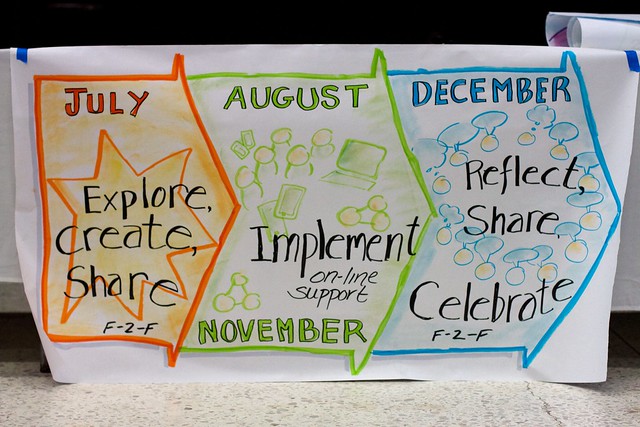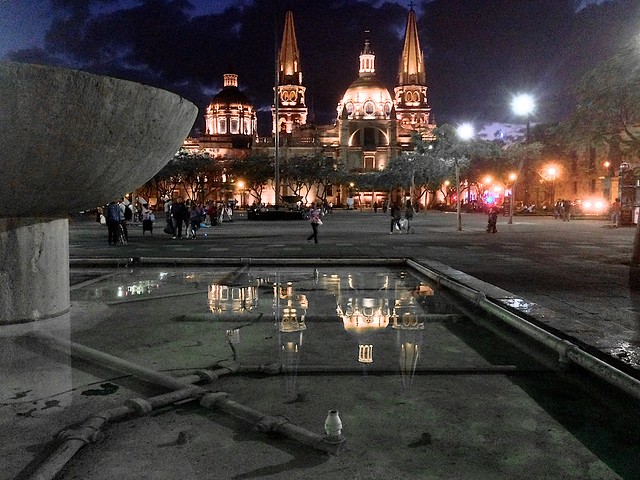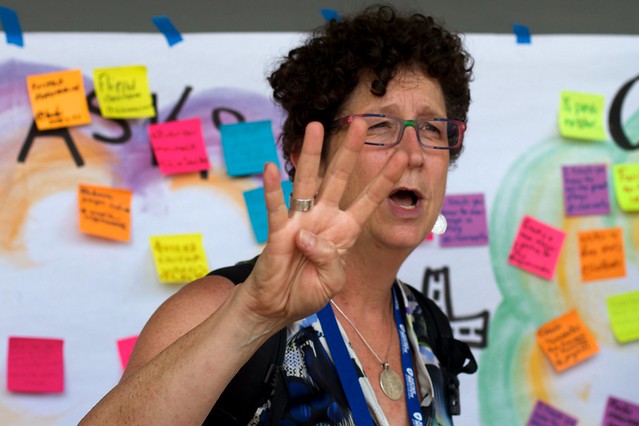I do not know where to begin writing. Back when I was just a puppy of a blogger, I’d document almost every session of a conference.
I look at this empty WordPress editing screen trying to figure how to describe the last two weeks spent in Guadalajara in the perhaps the most intense and most rewarding edtech experience I was ever a part of. I have tried to tell my local friends how warm, gracious, welcoming, fun were this group of 300+ educators and more people I met in Mexico. How it shatters most of the North American stereotypes of what Mexico is like.
Stalled.
Even among my 400+ photos (the thing I did manage to do every night, often at 3am), which one says it all? The one above is just a moment, but it captures to me the embracing of new technologies, the exuberance of sharing, listening and dialogue I saw in participants, and also just the love of having fun.
I have posts to write about the development of the web site .. er sites, also the use of the ds106ish Daily Try (which they are still doing), the expansion of features to use in the (again a spawn of ds106) Challenge Bank (which experienced over 2000 entered responses to 45 Challenges), the uptake on twitter. There are posts to be written about the studios I got to (try to) lead. There are posts about the people. There was the session on Openness I got to do with Brian Lamb that ended up better for being far from what we might have done without some Nancy White intervention. There are posts…
Woah, blog. Let’s rein this in. So here is a bit of how I hopped on this project that is a collaboration of the Justice Institute of British Columbia (JIBC) and the University of Guadalajara (UdG).
How I Fell Into the Project
When I start to think about the series of steps that lead me to Guadalajara it ends up as another story of connection (note that in the next few weeks I will incessantly drop hints for my call for shared stories).
It goes back to the early part of this year during my fellowship at TRU– working with Brian Lamb, we sought regional guests we invited in as part of our You Show scheme. One of them was Tannis Morgan from the JIBC; I knew we may have crossed blog paths when she was at UBC, but I also was lucky she contributed an OER Story for me that embraced my play on Sasquatch.
The relevance for us was the courses the JIBC were turning out with WordPress; and Tannis was even a good enough sport to play the part of “The Consultant from Vancouver” who shook things up in our video semi-narrative.
Brian had mentioned Tannis was leading a project in Mexico he hoped to be a part of, so after spending time with Tannis in Kamloops I let it be known that if there was something I could do for the project, my interest flag was raised. Maybe it was the approach Brian and I were doing with the You Show, including a bit of goofiness (?), maybe it was her interest in doing something in an open web form, maybe it was…
And that’s how it kind of fell into place. One thing leads to another.
If I understand correctly, the project Tannis was leading had the connection via a recommendation for the JIBC to UdG from Tony Bates and so somehow this feels like a bit of six degrees of edtech connection (sans Kevin Bacon).
The Project Itself
The project design document describes it:
The purpose of this document is to present, at a high level, the design considerations for the Student Centred and Mobile Learning program, co-developed by JIBC and the University of Guadalajara.
The 150 hour program will be designed to provide University of Guadalajara professors with the knowledge and application of student centred and mobile learning. The program will provide learners with the opportunity to practice and apply in both face-to-face (F2F) and online components, and will be scaled to consider the varying levels of experience and expertise that learners will be coming with.
The goal of this faculty development program is for University of Guadalajara professors to confidently integrate student centred and mobile learning strategies and activities in their courses. Through the use of practical examples, challenges and experiential learning, the program will provide learners with the tools they need to meaningfully plan, design, implement and share student centred and mobile learning in their courses. Learners will be expected to collaborate, share, and contribute openly to a community of practice that fosters the enrichment of student centred learning experiences with the use of mobile learning technologies (ipads).
I really like the approach specified in the design and described by Tannis as focused around “Studios”. It’s a metaphor that has long spoken to be as ideal for creativity and learning technology in a hands on design but also in proximity to others. It rings of how we built out ds106:

flickr photo shared by cogdogblog under a Creative Commons ( BY ) license
Many faculty development programs saturate learners with too much information in too little time, and information takes priority over hands-on doing. This program is trying to avoid this and at the same time present the UdeG faculty with a different kind of learning experience.
This is one thing I really like about the approach and the investment UdG is putting into this project. Rather than a one shot “training” or “faculty development with technology” approach, this UdG Agora spans over 6 months:

flickr photo shared by cogdogblog under a Creative Commons ( BY ) license
For the participants it is a “diploma” in Mobile Teaching and Learning— they came bearing more motivation than typical volunteer attendance in Faculty Development programs.
Rather than just some iPad handout, the UdG had a formal ceremony with UdG Rector Bravo Padilla personally congratulating each recipient like a graduation ceremony
Ceremonia de entrega de iPads para docentes inscritos en el “Diplomado de Enseñanza y Aprendizaje Móvil II pic.twitter.com/wVV1e7LWcB
— InnovaciónCurricular (@educontinuaciep) July 10, 2015
The July Sessions
This first phase in July 2015 was giving 300 faculty (150 each week) an intense hands on face to face experience with not only technology, but teaching strategies and community building. There was huge value in starting with a F2F event and then extending it into an online portion, and back again.
Its pretty likely you have not heard much of the UdG- they are a comprehensive public university that is spread across the state of Jalisco, at least 150,000 students. Students can attend for low to almost no costs, somehow shattering the cost disease of higher education in North America (I am not fully clear on the economics here, passing on what I was told).
UdG has close to 500 fully online courses via their Virtual University System and have five MOOCs being prepared.
All participants were given a top of the line iPad, and also, I have never heard of this done, they gave them all a paid for data plan as well. But this was not about iPads, but a vehicle for thinking about strategies for using mobile tech. The participants are not forced to use iPads, its their choice on what implementations they do.
The program for July was designed as predominantly Studio sessions in classrooms with a size of about 30 participants each. Some were simultaneous Foundational Studios (ones we wanted all participants to do) and multiply offered Learner selected Studios.
For example, in a week, I ran four Short Form Video studios and three Recording/Creating with Audio Studios (uh oh the Studios deserve one or more blog posts). Studios were scheduled for 90 minutes, allowing for some short introduction/demonstrations (I have to say, using Airplay from the iPads to demo the apps was critically essential, when it worked).
Participants were then free to choose to complete at least one Challenge from a list of maybe 4 or 5. These are all housed on the Challenge Bank (3 or 4 pending blog posts) using the WordPress Theme I developed modeled after the ds106 Assignment Bank. What is different from ds106 is our participants were not writing up their work in a blog, so the mods I added permitted them to compose something more like a blog post that exists in the Challenge Bank as a “response”.
The Challenges were deliberately small in scope, and not on its own relevant to the overall mission to design parts of their courses (that is its own studio). The week was really immersion into ideas, media, and approaches. The work for participants begins in the online phase.
Future Components
Starting in mid-August, we start an online community phase of the project where the faculty have to flesh out ideas they will apply to their current courses that focus on the projects aims of more student-centered teaching and use of mobile technology. We are setting up a discourse powered site as the “place”. Studios will continue as a means for more development, and we are inviting participants to lead studios as well:
The online portion will last 8 weeks and will have learners actively integrating student-centred strategies into their classes and getting student feedback that is shared back with the community. This portion is built around challenges that are completed in conjunction with their teaching, helping learners advance their own skills, knowledge, and confidence with guidance from JIBC facilitators, coaches, and their own learning community. Learners will be actively contributing to open resource/s.
In the last day of the July sessions we introduced a strategy of multiple levels of working together. We had people form preliminary “triads”, groups of threes, to being the fleshing out of perhaps their first implementation. They were encouraged to share contacts and figure out a best method for staying in touch with each other (email, WhatsApp, facebook, sms, whatever they choose). In the discourse site, they will be out into larger cohort groups of about 30, and there will be parts where they are in the larger community of 300+.
The later goal is for them to experiment with 2-4 course redesign challenges applied in their courses, and deploy them with means of collecting student evaluation. All will be shared in the December event, planned as more of an Unconference, where we convene again F2F.
Why Agora?
I got to be part of the project planning trip in late April, when Tannis, her JIBC colleague Barb Kidd, and I visited the UdG to meet with Sandra Cobain and her team from CIEP (Coordinación de Innovación Educativa y Pregrado). We were literally building out the project in a studio like environment, even running a prototype version of a Studio.
On the first day I asked for some metaphor help for the project, since my web and program design starts with a metaphor. The word “studio” like where artists or craftspersons work did not have a lot of resonance. I gave them homework to return the next day with a metaphor from the project.
This was a beautiful moment, because I did not want to hand them a metaphor, and it was Coco A who come back the next day with the metaphor of the “Agora”. It was interesting as a Greek term for gathering place, but it translates to Spanish. But it fit very well for what we saw in the downtown plazas near our hotel

flickr photo shared by cogdogblog under a Creative Commons ( BY ) license
Every night the plazas were full of people, families, kids, singers, bicycle riders, all sharing a public gathering space.
This worked for everyone. Actually, Coco’s first suggestion for the metaphor was “Agora 21” for Twentyfirst Century Agora. I ran into some challenges with hashtags and domains, and we settled on a more generic “the Agora” as a project idea/domain (for possible expansion elsewhere) and building the UdG one as http://udg.theagoraonline.net/ and #UdGAgora in twitter.
I started using images of the Rotonda de los Jaliscienses Ilustres we saw nearby; it had a Greek style and seemed again to be a popular gathering place. It’s a monument to famous artists and figures from Guadalajara–

flickr photo shared by cogdogblog under a Creative Commons ( BY ) license
But as pointed out by our UdG colleague and co-faciliator, Kike, it’s known more informally as a place commemorating dead people. So with some suggestions from Kike, I found and used an image from an auditorium at the university for the main site:
People, People, People
This post is way past long, and the people who were part of this project deserve its own post. That might happen.
When approached abut this project Tannis “warned” me that her project management style was “loose” and “evolving” alluding to the fact we would be inventing much on the fly. My response was “are there other ways to run projects?”. That”s where I live and breathe.
In addition to Tannis and Barb, we were joined in July with Brian Lamb, Nancy White, Jorge Enqrique (aka Kike), and jumping in to the fray bravely 9 days prior, Terri Bateman.
In May when Tannis asked for recommendations on who could be brought in to lead the process/facilitation aspects, I said, there is no one better and worth working with than Nancy White, but I added that she is insanely busy, and likely committed to a regular visual facilitating event she does in July. So there were leaps of joy when Tannis said Nancy was going to be in the mix.
Yet another post it would take to describe how much Nancy adds to a project like this, from wisdom to energy to ideas to just sheer silly fun singing made up songs in the car.

flickr photo shared by cogdogblog under a Creative Commons ( BY ) license
One more thing that worked really well for our panning and brainstorming was creating a Slack for our working group.
One More Thing Before This Post Sinks The Internet: Emergent Learning
On the Monday of the second week in Guadalajara I participated in a live Google Hangout for Connected Learning, on the topic of Emerging Trends in Open Scholarship. I was there by invite of Maha Bali (see her post in the event).
I was somewhat hesitant so I hardly consider myself an open scholar, but that was not the focus. In fact, the work we were in the middle of in Guadalajara really fit the discussion well. Panelist Suzan Koseoglu had written about the ideas of the differences in “technology of emergence” vs “emergent technologies,” she had heard Gardner Campbell speak about at #Et4online.
And it struck me that so much of what we were doing in UdGAgora are firmly situated in creating technologies of emergence for our participants. And oh, did they do that.

Meme created by UdGAgora participant- help I cannot find the source!
Another ∞-1 posts to write…
Top / featured image: flickr photo by cogdogblog http://flickr.com/photos/cogdog/19972464992 shared under a Creative Commons (BY) license



Great post/storytelling. You may have given me the energy to start reflecting and writing. Si si si!
Yes, Nancy, I look forward to your post. I was still decompressing from the conference *before* the week I spent with you and now am in the middle of an incredibly exciting and intense meeting of 1500 faculty from the Tec de Monterrey where I keep sharing what I experienced last week including #Confusiasm of course.
Please keep sharing which is something I admire of both you Nancy and Alan. You make the internet a better place.
Hi Alan, thanks for your post. It’s really great to learn more about the project–sounds really amazing. Hope you’ll talk more about how they build community in your follow up posts.
After reading your post I wrote a blog post on technologies of emergence (https://differentreadings.wordpress.com/2015/07/29/technologies-of-emergence/). It’s more explanatory than the post you mention here:) And thanks for the mention, it’s always a great feeling to get a pingback!
YES! This is what I was looking for as a reference, it really gets to the heart of the teaching and project environments I enjoy most.
Hi Alan
Yes, a long post, but you’ve clearly got a lot to report. It all sounds pretty exciting!
The Agora is a terrific metaphor. A public square, constrained by the buildings that flank and contain it, is a space that allows for all sorts of activity and free associating. Trees, fountains, bollards and street furniture provide a physical focus for people to gather around while they engage in conversation. Others lurk from the edges. Creating a learning experience is a similar design challenge — provide the necessary boundaries and constraints and supply enabling resources as appropriate.